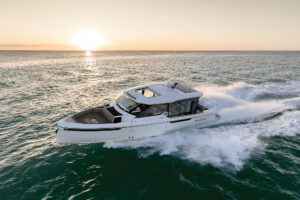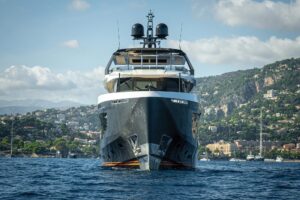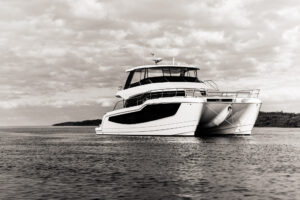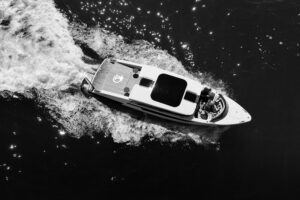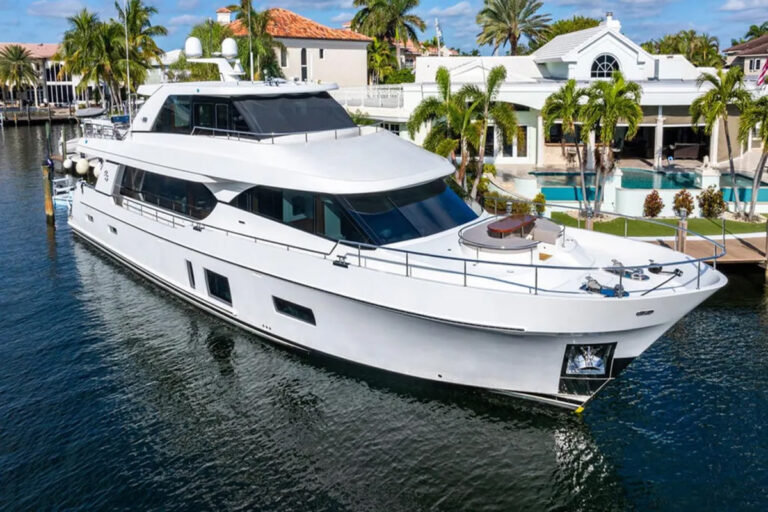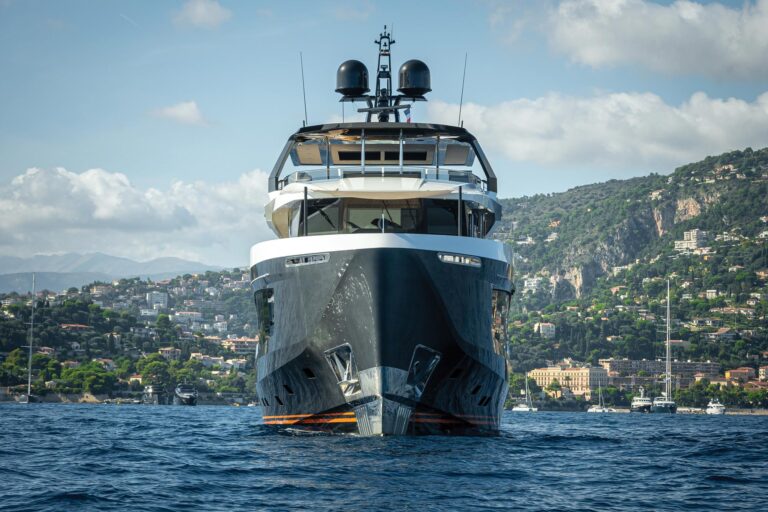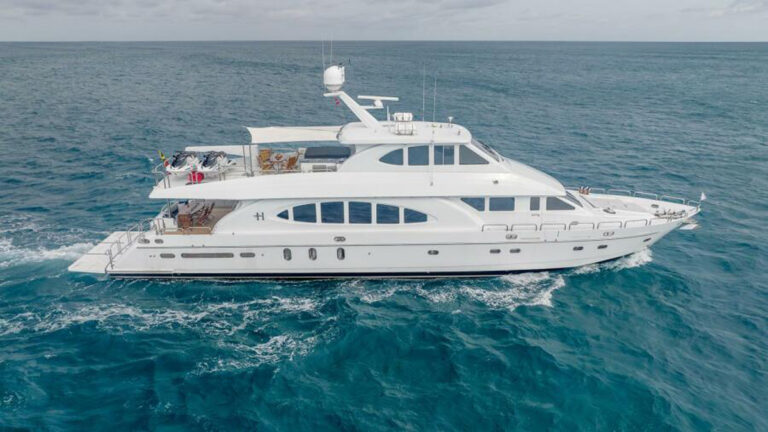What a day for a sea trial. The coast of Connecticut swayed, bent and twisted under the edge of a tropical storm that had been tracking northeastward for a couple of days. Winds blew a consistent 25 knots and gusted into the high 30s. I dodged broken branches and other debris as I drove along the Connecticut River to the town of Deep River to meet Lynn and Don Obitz and their new Krogen 58.
Deep River was one stop on the couple’s escape route south. Don Obitz had backed into semi-retirement from his business in Massachusetts, trading the pressures of the workaday for the joys of a vagabond life on the high seas-or low. Could they have chosen a better boat for their adventures? Maybe, but their 58, christened Landd Ho (Landd stands for Lynn and Don), seemed perfect for them.
Mention of the word “perfect” no doubt makes most of us think of “flawless”. No boat is flawless, but a great many of them can be perfect in the word’s other meanings. Webster states: “satisfying all requirements; lacking in no essential detail. As far as Lynn and Don Obitz are concerned, Landd Ho is the perfect boat. She’s a stable liveaboard that offers easy motion, a quiet ride and more stowage than the couple may ever fill.
Stepping aboard the 58 is like boarding a small ship. She completely ignores the extra weight of a single person standing on the threshold of the portside boarding door. Nor does the yacht react in a significant way to one’s wandering around her perimeter. Part of this huge dose of initial stability comes from a half-load displacement of nearly 97,000 pounds, the other part from her firm bilges. Negligible motion, especially at anchor or in the slip, adds to the comfort of the crew and guests as they go about their routines.
At sea, a gentle motion is even more important. I’d never thought of the Connecticut River as a rough body of water, but it certainly was during my brief sea trial. The wind whistled down the river, accelerating in the venturi of surrounding hills. Landd Ho tested her docklines as we made ready to cast off.
Don Obitz had a moment of anxiety backing out of the slip in the high winds, but the combination of twin engines and a powerful bow thruster made the exercise painless. The 58 is fairly tall, but she has enough displacement and hull below the waterline to keep her from sliding off like a leaf the way light, shallow boats often do. Obitz engaged the stabilizers and steered Landd Ho down the river and downwind. We huddled in the pilothouse.
Fantasies played havoc with reason as Landd Ho battered the short, steep waves on the river. Her extraordinarily quiet running (between 62 and 65 decibels at the helm at 9 knots) and solid presence beneath my feet sent my imagination to distant ports of call. Cherry joinerwork and a cozy settee in the pilothouse added to the attraction. I’d set the autopilot, pour a mug of coffee and settle down with a book while the rain and wind lashed the reverse-rake windshield. Of course, I’d look up from time to time, check the heading and make sure the radar’s perimeter alarm hadn’t missed a target.
Landd Ho tracked like a freight train in the following winds and seas. She engages the sea with a fine entry, which grows to full beam in the first third of the hull. A full-length keel, moderate deadrise amidships and twin skegs keep her on course. She ought to track well down the face of big waves, and her bow sections have all the reserve buoyancy she needs to keep her foredeck out of the water.
She’s as stable as a church in hard turns when the stabilizers are working. We disengaged them and executed a lazy S-turn. The yacht heeled predictably, but in no way alarmingly, to the outside of each turn as we took the full force of the wind on the beam.
Back in the slip, the Obitzes took me on a tour of the accommodations. I was ready to move aboard the moment I stepped into the saloon, but I developed a genuine lust for the office on the port side belowdecks. Bookshelves built onto the bulkhead above the desk would hold most of my nautical collection. Cabinets outboard to port of the workstation and drawers to starboard would swallow all the other paraphernalia of a working writer/voyager. Kadey-Krogen offers this space as a den/stateroom equipped with a small desk and an L-shape berth that converts to a double. Opposite the office is a stateroom with two single berths.
The master stateroom is all the way forward and has more stowage than I’ve seen in a yacht this size. It has 16 drawers devoted to clothing, a hanging locker for the female crew (it’s 5 feet from top to bottom) and a separate one for the male. The berth lifts on gas struts to reveal cavernous stowage divided into compartments. The berth is 7 feet long. Natural light floods the area from two portlights each side and a pair of 24-inch-square hatches in the overhead. These are large enough to let an adult of normal size crawl to safety in an emergency.
Displacement yachts benefit from deep bilges, and Kadey-Krogen uses these areas for the machinery room, a workshop, additional dry stowage and a stand-up engineroom. The lazarette back aft is nearly large enough to house a stateroom. The Obitzes had their bicycles in there.
Most liveaboard couples tend to outgrow their stowage in a matter of weeks. The Obitzes may need a year or two. “Can’t fill up the space”, Lynn said.
Going to sea in a yacht of this caliber seems perfectly sensible to me. She’s as seaworthy as anyone could want, thanks to her watertight compartments and sturdy composite construction. I was sad to leave the Krogen 58, because the workaday realities would stifle my fantasies of a life on the water.
Contact: Kadey-Krogen Yachts, (800) 247-1230, (516) 286-0171; www.kadeykrogen.com.

